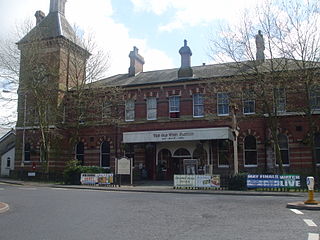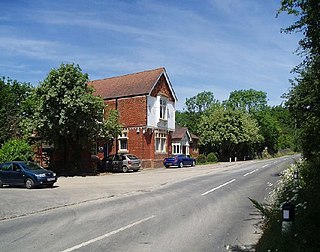
The Bluebell Railway is an 11 mi (17.7 km) heritage line almost entirely in West Sussex in England, except for Sheffield Park which is in East Sussex. It is managed by the Bluebell Railway Preservation Society. It uses steam trains which operate between Sheffield Park and East Grinstead, with intermediate stations at Horsted Keynes and Kingscote.

The Lavender Line is a heritage railway based at Isfield Station, near Uckfield in East Sussex, England.

Lewes railway station serves the town of Lewes in East Sussex, England. It has five platforms and is on the East Coastway Line, 49 miles 74 chains (80.3 km) from London Bridge via Redhill. Train services are provided by Southern.

Uckfield railway station is the southern terminus of a branch of the Oxted Line in England, serving the town of Uckfield, East Sussex. It is 46 miles 8 chains (74.2 km) from London Bridge.

Barcombe is an East Sussex village and civil parish in the Lewes District of East Sussex. The parish has four settlements: old Barcombe, the oldest settlement in the parish with the parish church; Barcombe Cross, the more populous settlement and main hub with the amenities and services; the hamlet of Spithurst in the north east and Town Littleworth in the north west.

Rhyl railway station is on the Crewe to Holyhead North Wales Coast Line and serves the holiday resort of Rhyl, Wales.

Wrexham Central railway station is the smaller of two railway stations serving the central area of Wrexham in Wales, the other being Wrexham General. The platform can accommodate a three car diesel train, but has room for platform extension. It is the southern terminus of the Borderlands Line, also known as the Wrexham-Bidston line, which links north-east Wales to Merseyside.

Hartlepool is a railway station on the Durham Coast Line, which runs between Newcastle and Middlesbrough via Hartlepool. The station, situated 18 miles 5 chains (29 km) south-east of Sunderland, serves the port town of Hartlepool in County Durham, England. It is owned by Network Rail and managed by Northern Trains.

Haltwhistle is a railway station on the Tyne Valley Line, which runs between Newcastle and Carlisle via Hexham. The station, situated 22 miles 66 chains east of Carlisle, serves the market town of Haltwhistle in Northumberland, England. It is owned by Network Rail and managed by Northern Trains.

Tunbridge Wells West is a railway station located in Royal Tunbridge Wells, Kent. It is one of two railway stations in Tunbridge Wells constructed by rival companies. The other, Tunbridge Wells Central was opened in 1845 by the South Eastern Railway (SER). Tunbridge Wells West was closed to mainline passenger services in 1985, but part of it still remains as a heritage railway line. Opened in 1996, it stands next to the original engine shed. The line is called the Spa Valley Railway.

Kingscote railway station is a preserved railway station on the heritage Bluebell Railway, located in West Sussex, England.

Ardingly was a railway station which served the West Sussex village of Ardingly in England. It was opened on 3 September 1883 by the London, Brighton and South Coast Railway (LBSCR) closed eighty years later and is currently used as an aggregates depot. The Bluebell Railway owns the trackbed from just east of the station to Horsted Keynes and has long-term plans to rebuild the line.

Horsebridge was a railway station on the closed Sprat and Winkle Line which served the Hampshire village of Houghton. It closed in 1964, a casualty of the closure programme proposed by the Beeching Axe which sounded the death knell for many rural railway stations.

Withyham was a railway station on the Three Bridges to Tunbridge Wells Central Line which closed in 1967, a casualty of the Beeching Axe. The station opened on 1 October 1866 and the buildings were designed by Charles Henry Driver. The station building survived the closure and is now a private residence named the "Old Withyham Station"; much of the trackbed as far as Groombridge and Three Bridges are part of the Worth Way and Forest Way cyclepath/footpaths.

Barcombe Mills is a small settlement and an area of countryside including a local nature reserve near the village of Barcombe Cross in East Sussex, England. It is located in the civil parish of Barcombe in the Lewes District. It is an important area for its wildlife, natural environment and water storage. The River Ouse and Andrew's Stream, one of its tributaries and popular for fishing, flow through the area and Barcombe Reservoir is adjacent. The area includes a small hamlet and some farms, including Barcombe House, and a water treatment works.
The Wealden Line is a partly abandoned double track railway line in East Sussex and Kent that connected Lewes with Tunbridge Wells, a distance of 25.25 miles (40.64 km). The line takes its name from the Weald, the hilly landscape the lies between the North and South Downs.

Barcombe was a railway station serving the village of Barcombe in East Sussex. It was part of the East Grinstead to Lewes line, part of which now makes up the Bluebell Railway. The station was originally opened as "New Barcombe" to distinguish it from the nearby station of Barcombe Mills and was changed to its more usual name on 1 January 1885. In 1897 goods sidings were installed at a cost of £1450.

Isfield is a preserved railway station on the closed section of the Wealden Line which served the East Sussex village of Isfield near Uckfield. Originally opened in 1858, the station closed in 1969 and was sold into private hands in 1983 to subsequently become the current centrepiece of the Lavender Line, a heritage railway.

Willoughby was a railway station on the East Lincolnshire Railway which served the village of Willoughby in Lincolnshire between 1848 and 1970. In 1886, a second larger station replaced the first following the opening of a junction with the Sutton and Willoughby Railway to Sutton-on-Sea and later Mablethorpe. The withdrawal of goods facilities at Willoughby took place in 1966, followed by passenger services in 1970. All lines through the station are now closed.
Thomas Harrison Myres FRIBA was an English railway architect who designed stations and ancillary buildings for the London, Brighton & South Coast Railway lines that were opened between 1880 and 1883, including several on what is now the Bluebell Railway. He was the son-in-law of the railway company's chief engineer, Frederick Banister. Although most of the lines for which Myres designed the buildings have been closed, many of his buildings survive as private residences. Several of the buildings designed by him are listed buildings, including the goods shed at Singleton in West Sussex which was declared Grade II in April 2013.





















